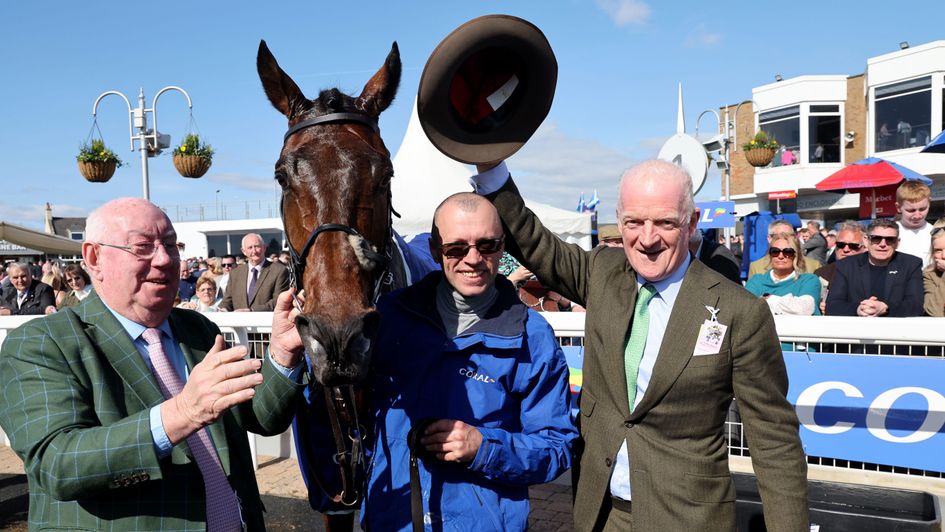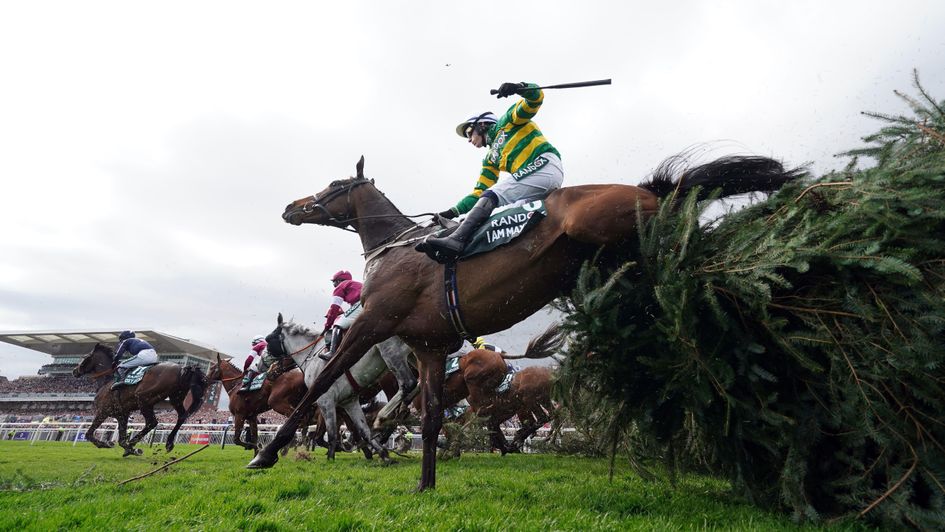Lewis Tomlinson assesses the evolving nature of the Randox Grand National following the release of this week's 90 entries.
What should a modern National look like?
It’s a question I asked when penning a similar piece last year, before we’d seen the effects of another raft of amendments to the most important race in the National Hunt calendar. Tweaks to the beginning of the race – the introduction of a standing start and a reduced run to the first – were perhaps less immediately noticeable to the once-a-year punter than the reduction in field size, only 32 heading to post at Aintree last season after a brace of late withdrawals.
Combined, they appeared to cause an immediate shift in the shape of the Grand National, not only in terms of the profile of the horses competed, but also the manner in which the race developed.
Now, the BHA and Aintree would certainly have been over the moon with the product they provided for the viewing masses last season. The race was no less competitive, with almost 20 runners still within touching distance of crossing the Melling Road, something surely helped by a lack of incident in heavy contrast to an unpleasant 2023 renewal which sparked the latest changes.
No negative headlines, a well-backed winner and an entertaining finish... a job well done?
A Grand National without a faller would’ve been scarcely believable even a decade ago, but the lack of casualties was also mirrored in last year’s runnings of the Topham and Grand Sefton (only one unseat across both races) and wouldn’t have done much to bring round those purists who bemoan the loss of a 'proper' test around the course.
As the race has become safer, the National has begun to attract a higher quality of entrant, the first four home last season all with a Grade 1 on their CV, and it’s perhaps unsurprising that a greater emphasis on raw ability has developed as the less idiosyncratic the National has become.
I Am Maximus, in terms of profile, wasn’t out of the ordinary for a National winner; a second-season chaser with an Irish National already under his belt is about as traditional as it gets. Far less traditional, though – almost unimaginable once upon a time, in fact – is that I Am Maximus has accrued a Timeform 'x' (representing a poor round of jumping) on more than half of his chase starts. The reigning champion for the Grand National and current favourite to defend his title is bad at jumping. It’s hard to argue against that statement, but it’s perhaps as stark of a point that could be made by anyone wanting to criticise the 'softer' nature of the modern race.
To do him justice, I Am Maximus produced a relatively error-free round at Aintree last year and he undoubtedly possesses assets that have increased in value as the race has changed shape. Long gone are the days of a frenetic dash to the first, the 2024 renewal almost stop-start in fashion, the winner being able to produce such a turn of foot from the Elbow indicative of a contest in which the need for limitless reverses of a stamina has been drastically reduced. I'd also wager the steadier gallop benefits those who horses who are inclined to take the occasional chance at their obstacles; more time to measure the fences, more time to hold a position after an error.
So, while it’s welcome that we have a cleaner race going forward, and in some respects one which is almost certain to require a Grade 1-level of performance to win it, I do think it is a major shame that the field reduction has all but called time on the participation of lower-rated dour stayers, more traditional 'National types' finding themselves replaced in the line up by Grade 2 two-and-a-half milers from marks in the mid-150s.
Kitty’s Light, a horse with an almost unrivalled record of consistency in leading marathon handicap chases, could only sneak into the final spot in the line-up last season, whilst the likes of Desertmore House, Malina Girl and Annual Invictus, all of whom had landed significant staying handicaps previously in the season, found themselves amongst the unlucky sextet numbered 35-40 on declaration day.
It's easier to work out the lay of the land prior to the weights launch in this post-Phil Smith era and having collated the BHA and HRI official ratings for the 90 entries for this year’s race, I'd expect a similar enough story in terms of rating needed to get make the final 34-strong field. A mark of 146 saw Kitty's Light hold 53rd position after the initial weights launch, and there's very little change regarding numbers from the mid 140s-low 150s this time around, so Twig, Minella Crooner and Velvet Elvis appeal as likely types to sporting saddlecloth 34 in April.
That means 2023 runner-up Vanillier will probably need a helping hand from Martin Greenwood if he’s to make the journey to Liverpool again, whilst a slice of luck will be required for progressive stayers Mr Vango and King Turgeon, another win at Musselburgh at the weekend not certain to even be enough for David Pipe's Grand Sefton winner to find himself high enough in the weights.
Scottish National 1-2 Macdermott and Surrey Quest are others who’ll likely remain on the sidelines and calls for “Win & You’re In” races or for caps on trainer/owner entries to increase plurality will surely be loud again before April.

I’ve long been against both; for me, the fairest way to get in the lineup is to run the horse to their merits on the track and ensure they end up with a high enough rating, but I’m beginning to thaw on the idea of Win & You’re In contests. It would take a particular contrarian to argue that the likes of Adamantly Chosen or Janidil added more to last season's National than any of the aforementioned entries would do this time around, so the argument behind ensuring as many winners as possible of traditional trials and preps for the contest are guaranteed a run is one I’m much keener on now with the reduced field than when forty places remained up for the grabs.
That being said, it's not too rare for a Becher or a Welsh National to be won from a mark in the 120s and a qualification system benefiting trial winners could lead to a less-than-ideal scenario where one or two runners compete from a long way out of the weights on National day.
I’m still freezing cold on the idea of capping trainers, though. Fundamentally, horse racing is a competitive sport, so the idea of limiting individuals based on their previous success has never sat well with me, whilst I also worry that could lead a two-tier system amongst owners within bigger yards. Take Gordon Elliott’s 2019 squad, for example – the Cullentra handler sent out sent out more than a quarter of the field, but he had been forced to be more selective, would it have been easier to tell Michael O’Leary that one of his seven runners was off the team or the tell lads who owned Bless The Wings that their old boy wasn’t on the boat despite finishing third the previous year?
Elliott’s battalion this time makes up sixteen of ninety put forward for this year’s race, somehow representing a double-figure drop from his 2024 numbers, though all bar Three Card Brag available to back at 40/1 or bigger. Ten potential runners from the Willie Mullins yard is also three shy of the last year’s Closutton entry, though doesn’t lack for strength, with Nick Rockett and Minella Cocooner amongst those prominent in the market behind I Am Maximus.

There is more reason to be cheerful from a British perspective this year; the entire home entry last season was fewer than that of the Irish super-trainers combined and only seven UK-trained horses lining up on National day itself. The share of entries between Britain and Ireland is near enough half and half this time around, with sixteen home-trained horses possessing a rating of 150 or higher, a significant increase from only six in 2024. These include Grade 1 winners Royale Pagaille, L’Homme Presse and The Real Whacker, though it’s Cheltenham eye-catcher Iroko who is shortest of the bunch at a general 14/1.
It's also encouraging to see Paul Nicholls mob-handed in the National having been without representation for the last three renewals and without a top-ten finisher for over a decade. His Coral Trophy winner Kandoo Kid appeals as one of the more reasonable British-trained contenders, though the quartet entered by Nicky Henderson are all perhaps a shade more speculative.
So, what can we expect from the 2025 Grand National?
Safer, yes. High quality, yes. Irish dominated, yes, but not quite to the extent as may have been expected. The evidence of 2024 would strongly suggest some of the National’s uniqueness has been traded off in favour of a more palatable contest and part of me remains a shade worried about whether those in charge of race have perhaps been a shade too defensive with the changes; as bleak as it is to say, another fatality in a Grand National is a near-inevitability at some stage down the line and I’d have some concern as to what steps would be left to take should Aintree and the BHA find themselves under pressure from mainstream media once again.
It's a difficult task for those charged with trying to balance ensuring the future of the jewel in racing’s crown whilst retaining the essence of the race. I’d still be of the opinion that Animal Rising’s pre-race protests instigated the carnage that then followed in the grim 2023 renewal, that race rather anomalous amongst recent years in terms of its ugliness, but the fact that such a protest occurred in the first place highlights just how precarious a tightrope the modern Grand National sits on.
Personally, I’d have preferred to have seen whether the amendments to the start had any positive impact before cutting the field size as opposed having both branches chopped at once, but it’s not overwhelmingly hard to understand why a cautious approach was taken – and those who made such decisions must have been pleased with how the newest-look National transpired. And well, if my main gripe is that I’d quite have liked last season’s Kerry National winner to have made the cut, then I guess for the time being, I’m pleased enough too.
Just ten more Saturdays to go.
More from Sporting Life
- Racecards
- Fast results
- Full results and free video replays
- Horse racing news
- Horse racing tips
- Horse racing features
- Download our free iOS and Android app
- Football and other sports tips
- Podcasts and video content
Safer gambling
We are committed in our support of safer gambling. Recommended bets are advised to over-18s and we strongly encourage readers to wager only what they can afford to lose.
If you are concerned about your gambling, please call the National Gambling Helpline / GamCare on 0808 8020 133.
Further support and information can be found at begambleaware.org and gamblingtherapy.org.






